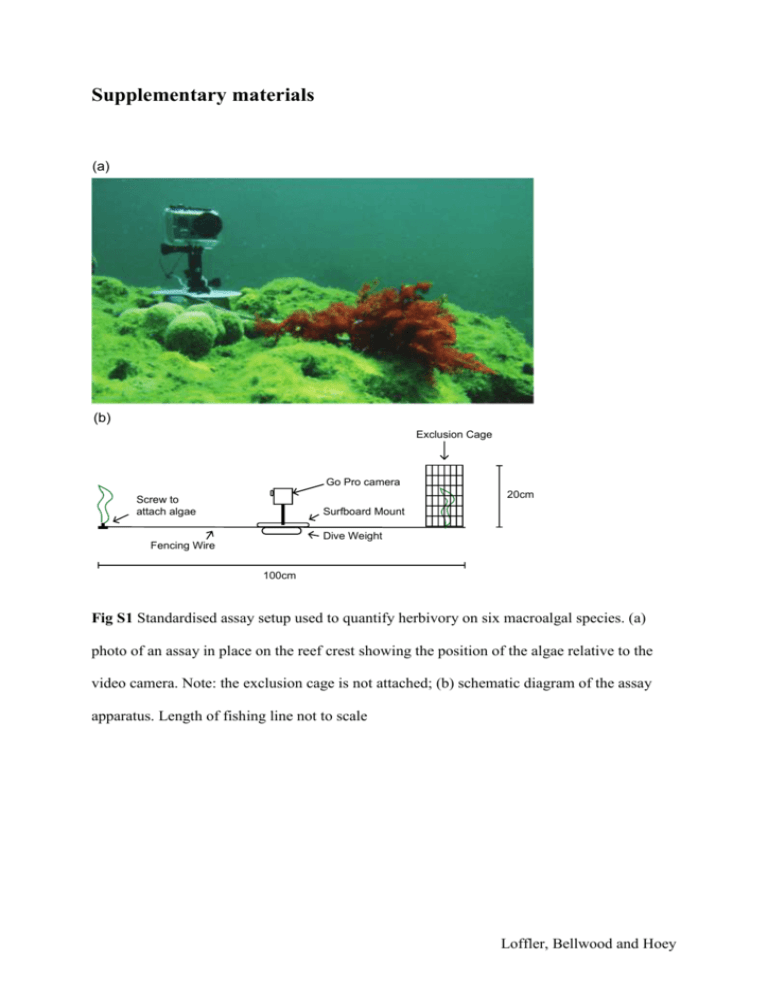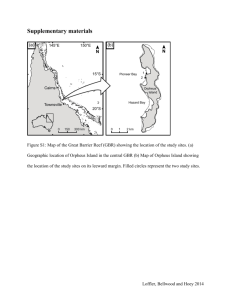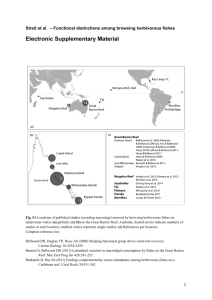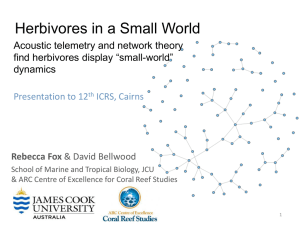Supplementary materials - Springer Static Content Server
advertisement

Supplementary materials (a) (b) Exclusion Cage Go Pro camera 20cm Screw to attach algae Surfboard Mount Dive Weight Fencing Wire 100cm Fig S1 Standardised assay setup used to quantify herbivory on six macroalgal species. (a) photo of an assay in place on the reef crest showing the position of the algae relative to the video camera. Note: the exclusion cage is not attached; (b) schematic diagram of the assay apparatus. Length of fishing line not to scale Loffler, Bellwood and Hoey 5 -1 Algal mass removed (g 4 h ; + SE) 6 4 3 2 1 0 1 2 6 5 4 3 Site Fig S2 Variation in macroalgal removal (g) among sites on Orpheus Island. Algal biomass removed is the total biomass removed from the six macroalgal species 2D Stress: 0.08 4C 5S 2C P latax spp. 6S Other s iganids 1C Scarus K yphosspp. us cineras cens 3C 4S 6C 5C Nas o1S unicornis S iganus doliatus Acanthurus s pp. P omacanthus s exs triatus 3S 2S Loffler, Bellwood and Hoey Fig. S3 Non-metric multidimensional scaling analysis showing variation in herbivorous fish assemblages among twelve locations (six sites and two habitats) around Orpheus Island. The analysis was based on Bray-Curtis similarities of the fourth-root transformed biomass data. Numbers 1-6 indicate sites, with ‘1’ being the northernmost site and ‘6’ being the southernmost site. ‘C’ denotes the reef crest; ‘S’ denotes the reef slope. A two factor ANOSIM revealed that herbivorous fish assemblages differed between locations (ANOSIM Global R = 0.250, p = 0.001), with sites 1 and 2 differing from the remaining four sites (Fig. S2). There was also some variation in fish assemblages between habitats (Global R = 0.259, p = 0.015). 30 25 20 Massive Porites sp. Turf Algae/EAM 15 6C 1C 3C 10 Factor 2: 32.56% 4C 5 4S 2S 0 Soft Coral 3S 2C 1S -5 Acropora sp. -10 5C 6S Other Hard Coral -15 Rubble 5S -20 -25 -30 -30 -25 -20 -15 -10 -5 0 5 10 15 20 25 30 Factor 1: 39.99% Fig S4 Principal component analysis showing variation in benthic composition across twelve locations (six sites and two habitats) on Orpheus Island. The analysis was based on the Loffler, Bellwood and Hoey covariance matrix of the mean of three transects within each habitat at each site. Numbers 1-6 indicate sites, with ‘1’ being the northernmost site and ‘6’ being the southernmost site. ‘C’ denotes the reef crest; ‘S’ denotes the reef slope. 50 Algal mass removed (% 4h -1) 45 40 35 30 25 20 15 10 -30 -20 -10 0 10 20 30 Benthic PC1 Fig S5 Relationship between benthic composition and consumption of macroalgae across twelve locations (six sites and two habitats) on Orpheus Island. The benthic composition is represented by the scores along the first axis of the PCA. Algal biomass removed is the total biomass removed from the six macroalgal species. Loffler, Bellwood and Hoey (a) 400 Kyphosus vaigiensis Siganus doliatus Siganus canaliculatus Pomacanthus sexstriatus Chaetodontoplus duboulay i Other siganids Naso spp. Scarus spp. 200 -1 Sum of mass-standardised bites (4h + SE) 300 100 0 (b) 400 300 200 100 0 1 2 3 4 5 6 Site Fig S6 Variation in the feeding rates of herbivorous fishes among 6 sites on the (a) reef crest, and (b) reef slope of Orpheus Island. Feeding rates are mean mass standardised bites (total bites × body mass in kg) summed across the six macroalgal species. Loffler, Bellwood and Hoey Table S1 Relative palatability of each species of algae used in the study Algal species Taxonomic classification Functional classification (Steneck 1988) Defence Acanthophora sp. Rhodophyta Corticated None Caulerpa sp. Chlorophyta Corticated Chemical Galaxaura sp. Rhodophyta Calcified Calcified, chemical Turbinaria sp. Phaeophyceae Leathery Leathery Laurencia sp. Rhodophyta Corticated Chemical Sargassum sp. Phaeophyceae Leathery Leathery, chemical Palatability References Readily consumed in macroalgal feeding trials Possesses toxic terpenoid, caulerpenyne which acts as a deterrent to herbivory Calcification and allelochemicals dissuade predation Tough, leathery morphology, making predation by many fish species difficult One of the first algae removed when used in macroalgal feeding trials A dominant macroalgal species after the occurrence of phase shifts. Readily eaten in feeding trials Littler et al. 1986; Reinthal and Macintyre 1994 Erickson et al. 2006; Raniello et al. 2007 Paul and Hay 1986; Rasher et al. 2011; Rasher et al. 2013 Littler et al. 1983 Reinthal and Macintyre 1994; Mantyka and Bellwood 2007 Hughes et al. 2007; Fox and Bellwood 2008; Cvitanovic and Bellwood 2009 Loffler, Bellwood and Hoey Table S2 ANOVA comparing loss of algal biomass (g) among sites, habitats and algal species. Data was square-root transformed to improve normality and homoscedasticity. Site Habitat Algal species Site x Habitat Site x Species Habitat x Species Site x Habitat x Species F df p 5.34 3.21 33.94 0.99 1.52 0.52 0.80 5 1 5 5 25 5 25 < 0.001 0.075 < 0.001 0.429 0.067 0.757 0.732 References: Cvitanovic C, Bellwood D (2009) Local variation in herbivore feeding activity on an inshore reef of the Great Barrier Reef. Coral Reefs 28:127133 Erickson AA, Paul VJ, Van Alstyne KL, Kwiatkowski LM (2006) Palatability of macroalgae that use different types of chemical defenses. J Exp Mar Biol Ecol 32:1883-1895 Fox RJ, Bellwood DR (2008) Remote video bioassays reveal the potential feeding impact of the rabbitfish Siganus canaliculatus (f: Siganidae) on an inner-shelf reef of the Great Barrier Reef. Coral Reefs 27:605-615 Hughes TP, Rodrigues MJ, Bellwood DR, Ceccarelli D, Hoegh-Guldberg O, McCook L, Moltschaniwskyj N, Pratchett MS, Steneck RS, Willis B (2007) Phase shifts, herbivory and the resilience of coral reefs to climate change. Curr Biol 17:360-365 Littler MM, Taylor, PR, Littler DS (1983) Algal resistance to herbivory on a Caribbean barrier reef. Coral Reefs 2:111-118. Littler MM, Taylor PR, Littler DS (1986) Plant defense associations in the marine environment. Coral Reefs 5:63-71 Mantyka CS, Bellwood DR (2007) Macroalgal grazing selectivity among herbivorous coral reef fishes. Mar Ecol Prog Ser 352:177-185 Paul VJ, Hay ME (1986) Seaweed susceptibility to herbivory: chemical and morphological correlates. Mar Ecol Prog Ser 33:255-264 Raniello R, Mollo E, Lorenti M, Gavagnin M, Buia MC (2007) Phytotoxic activity of caulerpenyne from the Mediterranean invasive variety of Caulerpa racemosa: a potential allelochemical. Biol Invasions 9:361-368 Loffler, Bellwood and Hoey Rasher DB, Stout EP, Engel S, Kubanek J, Hay ME (2011) Macroalgal terpenes function as allelopathic agents against reef corals. Proc Natl Acad Sci U S A 108:17726-17731 Rasher DB, Hoey AS, Hay ME (2013) Consumer diversity interacts with prey defenses to drive ecosystem function. Ecology 94:1347-1358 Reinthal PN, Macintyre IG (1994) Spatial and temporal variations in grazing pressure by herbivorous fishes: Tobacco Reef, Belize. Atoll Res Bull 425:1-11 Loffler, Bellwood and Hoey








